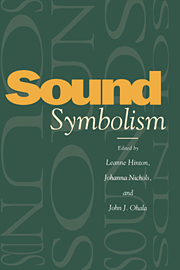Book contents
- Frontmatter
- Contents
- List of contributors
- 1 Introduction: Sound-symbolic processes
- PART I Native American languages north of Mexico
- PART II Native languages of Latin America
- PART III Asia
- PART IV Australia and Africa
- PART V Europe
- PART VI English
- PART VII The biological bases of sound symbolism
- 21 Some observations on the function of sound in clinical work
- 22 The frequency code underlies the sound-symbolic use of voice pitch
- 23 Sound symbolism and its role in non-human vertebrate communication
- Index
23 - Sound symbolism and its role in non-human vertebrate communication
Published online by Cambridge University Press: 04 August 2010
- Frontmatter
- Contents
- List of contributors
- 1 Introduction: Sound-symbolic processes
- PART I Native American languages north of Mexico
- PART II Native languages of Latin America
- PART III Asia
- PART IV Australia and Africa
- PART V Europe
- PART VI English
- PART VII The biological bases of sound symbolism
- 21 Some observations on the function of sound in clinical work
- 22 The frequency code underlies the sound-symbolic use of voice pitch
- 23 Sound symbolism and its role in non-human vertebrate communication
- Index
Summary
Introduction
It is ironic that sound symbolism – the non-arbitrary connnection between the sound shape of a vocalization and its function – has been a neglected topic in both linguistics and biological studies of communication. Expressive sound symbolism (henceforth ESS) is a fundamental trait of animal signals but, until recently, ethologists ignored the phenomenon. The irony lies in the reason for the neglect: ethologists adopted concepts underpinning their studies from mainstream linguistics (e.g. Marler 1961, Smith 1977). In biology as in linguistics, the physical structure of signals has not been an important consideration, except as a vehicle (with an arbitrary physical form) for “information” transfer.
There is nothing basically illogical about asking what “information” is being “transmitted,” but basic biological methodology requires the logic to be empirically based, objective, and to follow rules of the logic of natural selection. A causal account of communication would be cumbersome, involving neurophysiological description and statistical relationships found in communication systems (Markl 1985). “Information” should be used metaphorically as a descriptive term, a shorthand, rather than a causal agent. Information should not be used for something that is “conveyed” or “shared,” i.e. causing something.
Since linguistic logic is anthropocentric, the application of information as a causal agent to non-human communication is likely to violate the logic of natural selection, especially by confining us to the here-and-now timescale.
- Type
- Chapter
- Information
- Sound Symbolism , pp. 348 - 365Publisher: Cambridge University PressPrint publication year: 1995
- 2
- Cited by



